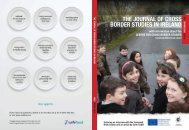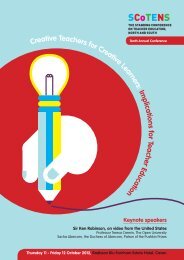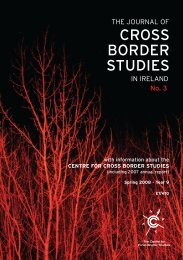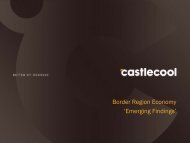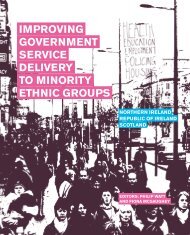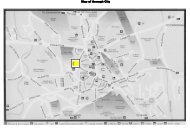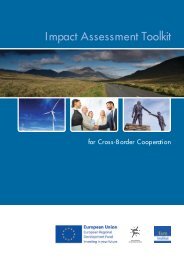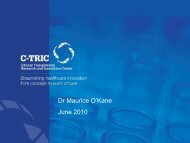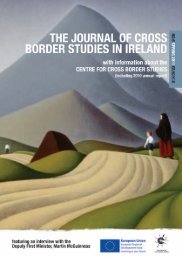4858 Mental Health Report - National University of Ireland, Galway
4858 Mental Health Report - National University of Ireland, Galway
4858 Mental Health Report - National University of Ireland, Galway
Create successful ePaper yourself
Turn your PDF publications into a flip-book with our unique Google optimized e-Paper software.
Findings from the Compatibility and<br />
Comparability <strong>of</strong> <strong>Mental</strong> <strong>Health</strong> and<br />
Related <strong>Health</strong> Data Sources<br />
primarily carried out for socio-economic monitoring purposes. The Irish survey,<br />
however, includes additional modules designed to allow wider assessment <strong>of</strong><br />
households and individuals. Interviewer administered questionnaires were<br />
completed by individuals randomly selected from the electoral register.<br />
The Northern <strong>Ireland</strong> Survey <strong>of</strong> <strong>Health</strong> and Social Wellbeing is similar to SLÁN in<br />
that it was the survey <strong>of</strong> health and behaviour risk factors among the general<br />
population in Northern <strong>Ireland</strong>. Over 3,000 households were selected from the<br />
Valuation and Land Agency list <strong>of</strong> private addresses in Northern <strong>Ireland</strong>. Each<br />
member <strong>of</strong> the household over the age <strong>of</strong> 16 years was asked to complete a<br />
questionnaire, administered by a fieldworker.<br />
While two other surveys in the Republic <strong>of</strong> <strong>Ireland</strong> were nationally representative,<br />
they related to specific population groupings - General <strong>Health</strong> Care <strong>of</strong> the<br />
Prisoner Population and Prevalence <strong>of</strong> Depression in Third Level Students. Both<br />
surveys used self-administered questionnaires completed in their respective<br />
settings. Similarly, the Survey <strong>of</strong> <strong>Health</strong> in the Northern <strong>Ireland</strong> Civil Service is<br />
specific only to the civil servant population and used postal self-administered<br />
questionnaires. The Cross-<strong>National</strong> Survey <strong>of</strong> mothers aged 55 years and over<br />
used nationally representative samples in both Northern <strong>Ireland</strong> and the Republic<br />
<strong>of</strong> <strong>Ireland</strong>. Interviews were conducted in the home with the women, and<br />
following the interview, a self-administered questionnaire was completed.<br />
The other adult surveys were either regionally based or relating to sectors <strong>of</strong> the<br />
local population. In the Republic <strong>of</strong> <strong>Ireland</strong>, rural populations were targeted in<br />
the <strong>Mental</strong> illness in an elderly rural population in <strong>Ireland</strong>: a prevalence study.<br />
The elderly were specifically surveyed in the regional <strong>Health</strong> and Social Services<br />
for Older People. The two other non-nationally representative surveys focussed<br />
on homeless men in Dublin and mental health specifically in the Western <strong>Health</strong><br />
Board area. There were no local surveys identified in Northern <strong>Ireland</strong>.<br />
Two population-based surveys were identified which are currently in progress.<br />
The INSURE (<strong>Ireland</strong> North-South Urban Rural Epidemiological) survey is a<br />
prospective investigation into age and demographic risk factors for suicidal<br />
behaviour (McClelland and Malone). The <strong>Health</strong> Status <strong>Health</strong> Gain Unit, NUI<br />
<strong>Galway</strong> is beginning a prospective investigation into health and inequalities using<br />
three age cohorts across various life stages in the western and eastern<br />
populations <strong>of</strong> the Republic <strong>of</strong> <strong>Ireland</strong> (Lifeways Cohort study). <strong>Mental</strong> health is<br />
an integral component <strong>of</strong> this study with self-reported measures and biological<br />
markers being used for assessment purposes.<br />
A summary <strong>of</strong> the mental health indicators and the measures used, sociodemographic<br />
and economic indicators, related lifestyle behaviours and mental<br />
health problems are shown for each survey in Table 7. In total, 14 different<br />
mental health indicators were identified from the various surveys, with 12<br />
different types <strong>of</strong> measurement scales used.<br />
96





